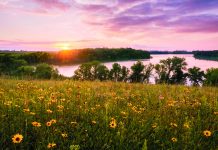Minnesota is known for its ecological diversity, but there are some landscapes that you just can’t find in our great state. Whether you’re longing to bask in the shadow of a towering, majestic mountain or trek through a brilliantly colored rainforest, the U.S. National Parks play host to a spectacular range of biomes. Check out this list of the best deserts, mountains, oceans, rainforests, and swamps in National Parks from Hawaii to Maine.
Deserts

Joshua Tree National Park
Twentynine Palms, California
Because of the harsh environment, desert wildlife has adapted in unexpectedly beautiful ways. The Joshua trees twist into Dr. Seuss-esque, spiky, and shadowy shapes across the deserts of Southern California and Joshua Tree National Park. The heat of the day juxtaposed with the pitch-dark, eerily silent cold of the night gives the desert its mysterious character and boundless horizons.

Zion National Park
Springdale, Utah
All throughout the American West, massive sandstone rock formations tower over the dusty desert landscape. Zion National Park, in southwest Utah, encompasses some of the most beautiful canyon land in the U.S., with its spectacular plateaus, mazes of canyons, and winding rivers that have brought green life to the desert.
Mountains

Glacier National Park
West Glacier, Montana
True to its name, Glacier National Park is home to some of the last remaining glaciers in the contiguous states. Its mountainous landscape in northwest Montana is surprisingly accessible to visitors (at least in the summer months), with the Going-to-the-Sun Road winding right through the valley, offering spectacular views of mountain peaks. Prepare to be blown away as you traverse the trails that meander right across the sublime cliff sides. Puffy white beargrass, shown above, coats the mountain prairies and adds to the unique landscape of the park.

Yosemite National Park
Yosemite, California
These sprawling panoramic views have inspired artists, hikers, and adventurers for centuries. At an elevation of more than 13,000 feet at its highest peak, Yosemite National Park’s spectacular landscapes will literally take your breath away. From its dazzling, cascading waterfalls to its sheer cliff sides, this jewel of the Sierra Nevada—hugging the border of east-central California—will satisfy your mountainous spirit.
Ocean

Acadia National Park
Bar Harbor, Maine
When you think of coastal paradises, Acadia National Park probably isn’t the first to come to mind. While this northern park, located on a large island off the coast of Maine, doesn’t have tropical beaches, it is home to the highest rocky headlands along the Atlantic. Acadia’s dramatically massive and jagged shorelines bring the mighty power of the ocean up close and personal on your hike—for a totally different kind of “North Shore.”

Dry Tortugas National Park
West of Florida Keys
Dry Tortugas National Park is on the opposite tip of the East Coast from rocky Acadia. This semi-remote Floridian park is only accessible by boat or seaplane, but the picturesque blue waters, diverse wildlife, and sparkling coral reefs are worth the trip. With less than 1% of the park made up of dry land, the best way to explore is via water. Snorkel with the sea turtles, swim in the crystal-clear water, and boat around the seven small islands that make up Dry Tortugas.
Rain forests

Hawaii Volcanoes National Park
Southern Big Island of Hawaii
Because of its near complete isolation from the mainland, Hawaii is known for its spectacular ecological diversity. At Hawaii Volcanoes National Park, you can find glowing pits of lava and huge plains of solid molten rock from the two active volcanoes, as well as wind- and ocean-carved rocky shores, twisting caves, and, of course, wild and colorful rainforests. Over 90% of Hawaii’s flora and fauna can’t be found anywhere else in the world. Wander under the moist, green canopy of Hawaii’s sprawling tropical rainforest, an ecosystem crawling with diversity and mystery.

Olympic National Park
Port Angeles, Washington
Contrary to popular belief, rainforests can be found in the contiguous 48 states. One of these mossy, fairy-tale forests is located in shadow of the mountainous Olympic National Park, just outside of Seattle. Olympic’s Hoh Rainforest is a temperate rainforest; its wet environment is home to giant conifers, hundreds of species of moss, and a diverse range of fauna. The blanket of emerald moss that coats the entire rainforest casts a mysteriously quiet aura over all who enter beneath the towering trees.
Swamps

Everglades National Park
Southern Florida
Florida’s sprawling swamps are protected in Everglades National Park, home to some of the most unique (and often endangered) species on Earth. Manatees, alligators, and the rare Florida panther are just some of the threatened or endangered fauna of the Everglades. Kayak or boat through the swamp to get the full, on-the-water experience. The hiking trails and boardwalks also bring you within feet of some of the park’s most interesting birds, like the pink Spoonbill, and lots of toothy reptiles.

Atchafalaya National Wildlife Refuge
Lottie, Louisiana
The bayous of Louisiana are home to some of the most interesting flora and fauna. In Atchafalaya National Wildlife Refuge, an hour west of Baton Rouge, hike, bike, or boat through these mossy swamps to find native wildlife and many migratory birds. Paddle through the lily pads and make sure to bring your binoculars, because Atchafalaya is famous for its excellent bird watching.








